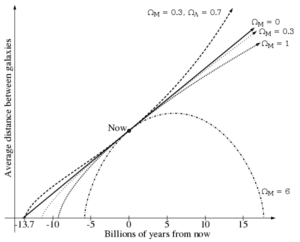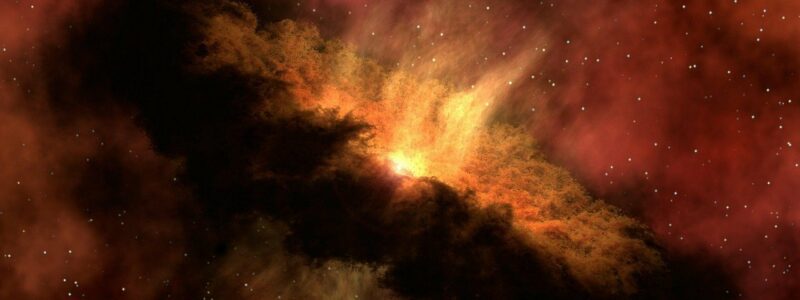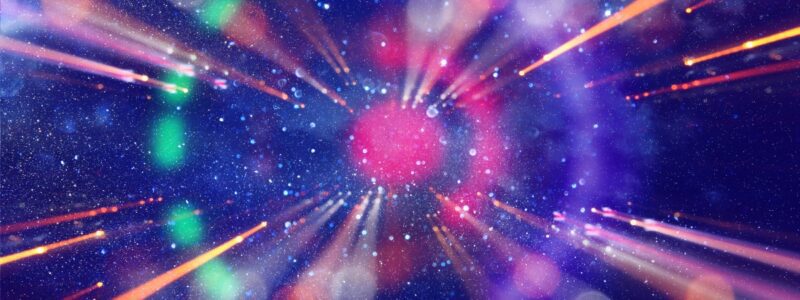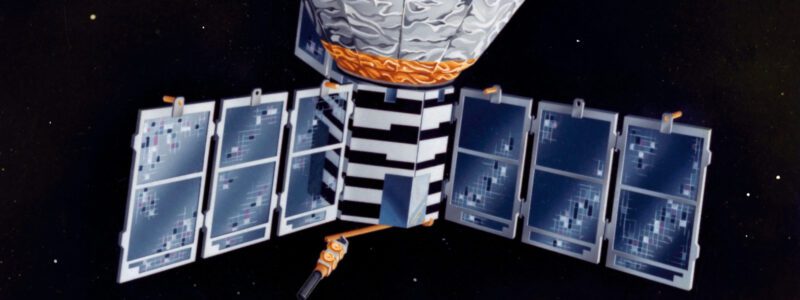The Big Bang
One of the greatest discoveries in the last century was the mechanism of the creation of the universe in the big bang. Cosmologists have established the most likely model for this creation was at a point in time about 13.8 billion years ago. At this point in time – just as explained in Scripture, the entire universe came into being.
The Universe includes all matter, time, and exotic matter flared into existence at a moment in time. The obvious theological conclusions associated with this beginning have been resisted by secular scientists. There have been many alternative proposals put forth to explain the Beginning but most others have been proven untrue.
This post will discuss some of the observational features discovered which support the Big Bang Model.
Helium Abundance Matches Big Bang Prediction
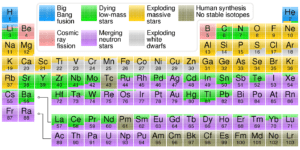
By Cmglee – Own work, CC BY-SA 3.0, Link
The big bang theory suggests that most of the helium currently present in the universe came into existence during the first few moments of its existence.
The model suggests the universe was extremely hot and dense at the creation moment. As the cosmos expanded, it became rapidly more cool much like a piston in a car.
By the time the universe was only a millisecond old, it had become a vast collection of protons, neutrons, and electrons. The only element in existence at that time was hydrogen. Hydrogen consists of only one proton and one electron.
Over the next few seconds while still less than four minutes old, the universe’s temperature was hot enough to produce nuclear fusion. During this time, protons and neutrons fused together to form elements heavier than hydrogen.
Nearly one-fourth of the hydrogen produced during the big bang was converted into helium starting at about the twenty-second period. There was only a tiny amount of other elements being formed at this time as well. These elements include lithium, beryllium, boron, and deuterium.
Deuterium is an isotope of hydrogen with both a proton and a neutron. All the other elements in the universe were produced much later (including some extra helium) in nuclear reactions associated with stars.
The exact amount of hydrogen which was fused into helium was determined by the density of neutrons and protons. Evaluation of the cosmic background radiation gives a predicted primordial helium abundance of 0.24668 plus or minus 0.00013 of the universe’s original amount of hydrogen.
Testing Helium Abundance
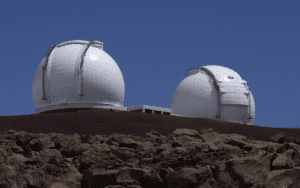
By T. Wynne / JPL – http://planetquest.jpl.nasa.gov/images/keckTelescopes-hi.tif, Public Domain, Link
The determination of the actual value of helium abundance at the beginning of time can be tested. This is done by observation of helium abundance in gaseous nebulae (which are large volumes of gas in space between stars) where new stars are being formed.
Since these nebulae have very little in the way of new star formation, their hydrogen and helium concentrations represent their initial values. These can be measured in many distant galaxies giving the additional benefit of looking back in time.
Two different teams of astronomers have published their results after measurements of distant nebulae.
A Mexican-Spanish team measured the abundance of 0.2446 plus or minus 0.0029 while an American team did similar measurements on another nebula and calculated the helium abundance at 0.2449 plus or minus 0.0040.
It is remarkable how close these two calculations are to each other, and to the predicted value noted above.
The observational confirmation of helium abundance predicted by the Big Bang theory helps substantiate the theory.
Deuterium Abundance
Deuterium is an isotope of hydrogen. While normal hydrogen has only one proton, deuterium has a proton and one neutron.
All the deuterium and lithium that exists today was produced during the first few minutes of the big bang. Both of these elements are used up in nuclear reactions associated with stars. Therefore, observation of the deuterium abundance will give a top limit to the amount that was produced.
Astronomers once again focused their research upon clouds of gas in distant galaxies. As with helium, the calculation of the predicted deuterium abundance came from the Planck observation of the cosmic background radiation.
The predicted value is 2.606 plus or minus 0.053 X 10^-5 of the original mass of hydrogen.
The amount of deuterium abundance could be measured in the star spectrograph using the Lyman alpha systems. A team of British and American astronomers determined the observationally detected deuterium abundance as being 2.547 plus or minus 0.033 X 10^-5.
Observed Spreading of Galaxies
Expansion of the universe should produce increased distances between galaxies of those closer in time to us (closer in distance) to those further back in time (when galaxies were closer together). This would require the measurement of many galaxies at various distances from earth.
Large telescopes have taken multiple images of galaxy clusters and so this simple observational requirement can be tested.
Images of galaxies that are more than 10 billion light-years away from us (and are therefore 10 billion years back in time) show they are so tightly packed together that their mutual gravity tends to tear each other apart.
Evaluation of hundreds of images taken by astronomers shows over many years a regular progression of galaxy distances from each other. While galaxies are initially close, over time, they drift further apart as the universe expands.
This observation helps to prove that at the beginning of time extrapolating backward, the universe began extremely small.
Cosmic Expansion Velocity – The Hubble Constant
It is now common knowledge that the universe is expanding. Another way to determine the truth of the big bang theory is to test the rate of this expansion from close to an initial event to the present.
Unfortunately, these measurements are difficult to make with enough accuracy.
Four methods for measuring the expansion velocity of the universe were used in a recent paper giving an average value of 68.65 plus or minus 1.21 kilometers per second per megaparsecs. A megaparsec is a million parsecs; a parsec is about 3.26 light-years.
Since the expansion rate of the universe is known, it then becomes possible to determine the age of the universe since the expansion started. The age of the universe determined from expansion velocity is 13.78 plus or minus 0.26 billion years.
This age agrees with cosmic ages determined from long-lived radiometric isotopes such as uranium-2389 and thorium 232 and the ages of the oldest stars.
The age of the universe turns out to be important for the existence of physical life.
Cosmic Cooling
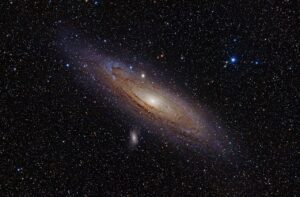
By Adam Evans – M31, the Andromeda Galaxy (now with h-alpha)Uploaded by NotFromUtrecht, CC BY 2.0, Link
The Bible declares unchanging physical laws and a pervasive law of decay consistent with known thermodynamics. These conditions imply the universe must cool over time.
Since the age of the universe is known with some precision from independent observations, and the rate at which the universe has been expanding is known, then the temperature of the universe can be calculated at multiple time frames.
This produces the temperature of the radiation left over after the Big Bang which is contained with the microwave background radiation.
The predicted cooling of the universe can then be compared to observed values.
The two methods for determining these past cosmic temperatures are:
- Measurements of the fine structure spectral lines in interstellar gas in quasars,
- The Sunyaev-Zeldovich anisotropies
Measurements of cooling of the universe over time agree with predicted values showing high confidence in the whole model. This helps to further establish the age of the universe and the Big Bang theory.
The astronomers noted,
No significant deviations from the redshift dependence of the CMB temperature predicted in the standard model have been found.
They further noted,
independently of theoretical expectations, measurements of the temperature-redshift relation of the CMB blackbody temperature provide a strong consistency check of the current Big Bang paradigm.
Cosmic Inflation
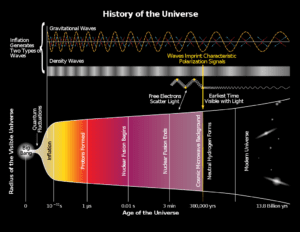
By Original: DrbogdanVector: Yinweichen – Own work, CC BY-SA 3.0, Link
Physical life in the universe has many requirements. The universe must expand at precisely the right rate throughout its history. The stars cannot be too young or too old to provide the elements and stability required for life. The universe must be homogeneous and uniform on large scale, but not on smaller scales.
Distances between stars and galaxies must not be too great or too little, and certain events that produce gravitational waves such as neutron star collisions must occur in order to provide the heavier elements.
The universe must also be thermally connected on all size scales. This can only occur if the universe underwent an early extremely rapid expansion – or what has been termed “inflation” when it was very young.
Cosmic inflation has been proven to have happened by evaluation of the scalar spectral index noted below. It is no longer just a proposal to explain the universe – it has now been proven to have occurred in brief moments after the Big Bang.
Breaking of Symmetry
When the fundamental physical forces separate from each other after the creation event, they are said to undergo breaking of symmetry.
As the fundamental forces of physics decoupled from each other as a result of the cooling, they lost their symmetry and the universe became more disordered.
Alan Guth proposed cosmic inflation in 1981 and noted it is an expected outcome of the symmetry breaking occurs. This inflation event is extremely quick lasting only for the tiniest fraction of a second.
If there were no cosmic inflation in the history of the early universe, there would be a signal in the measurement of the cosmic microwave background radiation. The measurement of something called the scalar spectral index helps to determine the manner in which this separation of forces occurred.
Scalar Spectral Index Proves Inflation
For a universe with no inflation event, the scalar spectral index equals 1.0 or greater. For a single inflation event, the scale would equal 0.98 exactly. For a universe that has had a complex inflation event, then the scale equals 0.96 – 0.97.
There have been three good measurements of this index which were from the WMAP and Planck satellites and the South Pole Telescope.
The Wilkerson Microwave Anisotropy Probe satellite determined this index to be 0.9697 plus or minus 0.0080. The Planck satellite map of the cosmic microwave radiation established the scalar index to be 0.9603 plus or minus 0.0073. Another team yielded the most accurate determination to be 0.9593 plus or minus 0.0067.
Statistical evaluation of the latter study shows that there is less than one chance in 900,000,000 that the universe did not undergo an inflation event very early in its history.
Primordial Magnetic Fields
A significant amount of research has been developed trying to find the primordial magnetic fields. These are thought to have occurred from the above-noted symmetry-breaking events that occurred during the first instants of the Big Bang.
It is thought that at these events, a small fraction of the energy released would result in what are now large-scale magnetic fields. Additionally, there are no other good explanations for the magnetic fields were they to be found.
Astronomers have found magnetic fields for all size scales except for the very largest ones they are specifically looking for. However, they also note that larger fields are weaker than the smaller ones.
In 2017, astronomers established an upper limit to the strength of the large scale magnetic fields using the best data available from the cosmic background radiation. They determined this upper limit to be no stronger than 0.91 Gauss.
Future experiments are being planned to try to locate the primordial magnetic fields. If this is possible, then depending upon the results, a much better understanding as to exactly what happened should be revealed.
Star Populations and the Big Bang
The age and type of stars provide better information concerning the age of the universe. The big bang model predicts a hierarchy in star formation.
The first-born stars will be composed only of hydrogen, helium, and trace lithium. Unfortunately, the model predicts that these fir stars would not be detectable with current telescopes. They would have formed when the universe was only 0.4 billion years old or 13.3 billion light-years ago.
No telescope currently exists which can measure the spectra of individual stars at this distance. These first-generation stars will have no elements heavier than lithium. If they are larger than the Sun, they would explode at the end of their life and seed the surrounding environment with heavy metals.
The second generation of stars would then incorporate these metals into their substance when they form. These second-generation stars comprise most of the stars in the universe.
Third generation stars then incorporate the ashes of exploded second-generation stars. The third-generation stars are referred to as Population 1 (Pop 1) stars. The Sun is a Pop 1 star; life is only possible on a planet orbiting a Pop 1 star.
Astronomers have discovered three Pop III stars – the very oldest. One of these stars is about 75% of the Sun’s mass and has the least amount of heavy elements. This star is 13.6 billion years old, making it the oldest star ever observed.
Japanese astronomers evaluated the amount of iron that would be expected in Population II stars and found it would inevitably be greater than found in the oldest star found. They substantiated the remote star as one formed as a Pop. 1 star. They determined that a star which possesses less than 100,000 times iron per unit mass than the sun must be a Pop 111 star
These stars provide another means for the determination of the age of the universe.
Universe Age and Type 11 stars
Second-generation stars contain the ashes of stars that went through their life-cycle and exploded. The larger of these stars were able to produce radioactive elements such as uranium and thorium. U-238 has a half-life of 4.468 billion years while thorium 232 has a half-life of 14.05 billion years.
By measuring the abundance of these radioactive elements in low-mass metal-poor population 11 stars, astronomers could determine the ages of the oldest visible stars.
In order to calculate the relative abundance of these radioactive elements, they compared them to the non-radioactive elements such as europium, osmium, and iridium. These are heavy elements that would also have been made in such a stellar explosion but would not have decayed.
Using this technique, they calculated the radiometric age as 13.2 plus or minus 1.5 billion years. Several other similar stars have been located which provide similar age estimates. When a reasonable estimate for the life-span of 0.5 billion years for the original Pop 111 star is added to this age, the predicted age of the universe is 13.7 billion years.
Cooling of White Dwarf Stars
The cooling rate of white dwarf stars provides another means for determining the age of the universe.
White dwarf stars are fairly common in the universe and consist of stars that have burned their nuclear fuel and are in the process of cooling. White dwarfs represent the embers of larger stars and cool in a predictable manner. They consist of degenerate matter meaning their cooling proceeds along a predictable pathway.
The nearest white dwarf is Sirius B which is only about 8 light-years away. Star will eventually accumulate sufficient amounts of helium to interfere with hydrogen fusion and will reduce its heat production. Gravity will compress the star more heating the star’s interior until the fusion of helium to carbon and oxygen by what is called the triple-alpha process. This will produce much more heat causing the star to expand. Because the surface area of the expanded star cools, it will develop a colder surface and become red.
Carbon and oxygen then build up in the star’s center and it becomes unstable, frequently becoming smaller and larger. Eventually, one of these oscillations causes the star to explode forming a planetary nebula.
The material left over no longer undergoes fusion reactions and has no more source of energy. As a result, it will gradually cool over time in a predictable manner. The temperature of the star will help determine its age.
White dwarf stars in a cluster of stars NGC 6397 suggest an age of 12.8 plus or minus 0.6 billion years. Adding the formation time for this star cluster of about 0.5 billion to 1.0 billion years, the age of the universe comes to be about 13.5 billion years.
Theological Implications
These various means for the determination of the age of the universe all point to a beginning about 13.7 billion years ago. The fact that these ways of measuring are independent – that is, they use different means for the calculation – suggest the result is valid.
The case for the big bang – a transcendent cosmic creation event – rests on very compelling evidence. There have been no findings which directly counter this conclusion
Still, many people have a negative opinion of the Big Bang partially due to their not understanding the science of cosmology. Some of these pieces of evidence are very recent and have not yet filtered out to the general population.
Many early scientists found the theological implications of a Big Bang to be so repulsive resulting in their dismissal of the entire theory as “crackpot.” One after another cosmic hypothesis was invented in a so-far futile attempt to get around these facts.
Today, there are only a handful of astronomers who are still holding out against the big bang and its theological implications. however, often, this refusal to accept the theory is based more on personal metaphysics rather than physics.
Summary
This involved page discusses many of the more recent discoveries supporting both the big bang hypothesis and the age of the universe.
Furthermore, all of these means for the determination of the age agree to a remarkable degree. These means utilized different means for this determination that are independent of each other.
The advancing science of cosmology joins the advancing sciences of biology and archaeology to support the Biblical narrative.
Cosmology supports the Biblical model that the universe was created from nothing – absolutely nothing – in a moment of time about 13.78 billion years ago.

